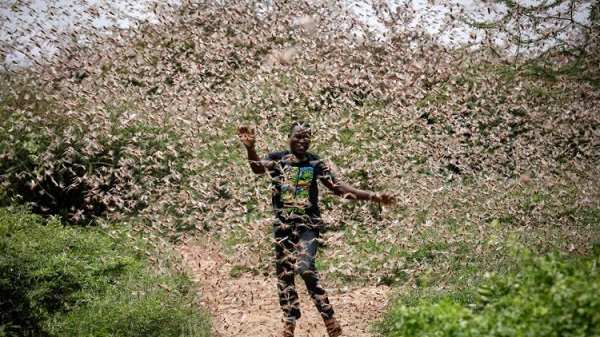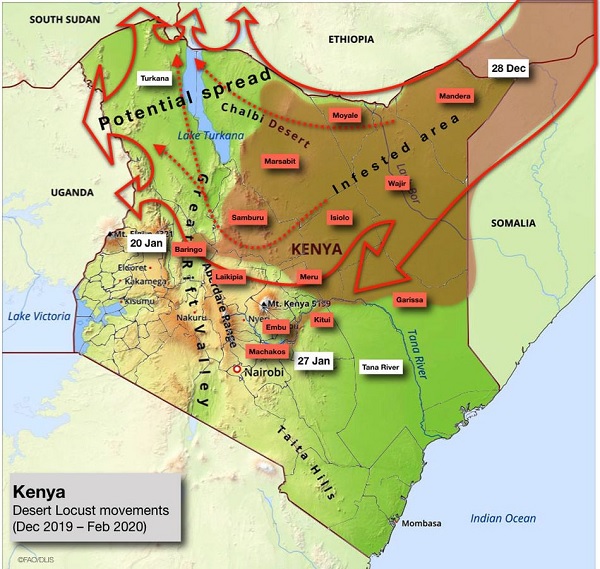
Crises from all over the world seemed to be competing to grab the headlines in January: Australia’s devastating bushfires, the impeachment trial in America, Brexit finally becoming reality, and the coronavirus outbreak in China. But Africa, often starved for attention, has a growing crisis of its own: a swarm of locusts, already the largest in decades, and still growing.
The term “locust” is sometimes used loosely for various kinds of swarming insects, such as the periodic cicadas which emerge in huge numbers on peculiar but regular 17-year or 13-year schedules, or the “Mormon crickets” (akin to katydids) which attacked Salt Lake in 1848 but attracted hungry seagulls. But properly speaking the word refers to about a dozen species of grasshopper, out of 10,000+ species in superfamily Acridoidea of order Orthoptera, with an irregular metamorphosis between “solitary” and “gregarious” forms. The Orthoptera are “hemi-metamorphosing” insects, which do not enter a pupa and emerge looking very different (as the “holo-metamorphosing” insects do); the young “nymphs” look generally similar to the adults except for not having their wings yet.
The “solitary” adult locust looks like an ordinary grasshopper, typically greenish in color, and ekes out a living in marginal habitat: the solitary form of Locusta migratoria, the species which sometimes reaches eastern Europe, was classified as a different species until Boris Uvarov, who studied insects in the Caucasus 1910-20, discovered the transformation. When solitaries encounter each other they sometimes rub legs, and after this ritual can transform within a few hours to the “gregarious” form with bright distinctive coloration and more energy directed to powering the wing. They stick together, the color helping any lost member find the swarm again, and eat voraciously to feed their heightened metabolism.
They also lay many eggs, which hatch into gregarious nymphs that show the colors right away, and swarm even though they can only walk, until they can fly. But lone nymphs grow into solitaries, and adults can also revert to solitary form, although this takes days rather than hours.
It is possible this was understood anciently. In Joel 1:4 “What the cutter left the locust ate; what the locust left the grub ate; what the grub left the hopper ate” we know the word “locust” as in Proverbs 30:27 “The locusts have no king but they all march in formation” or Leviticus 11:21-22 allowing, though in general creeping things (insects, reptiles, rodents) are unclean, those “with jointed legs above the four feet to leap on the earth” to be eaten, naming the locust and other species, or Exodus 10:12-15 as one of the plagues of Egypt, devouring everything (surely the reason Leviticus declares locusts kosher is because, when they go through, there may be nothing else left to eat). The word “grub” is for small creeping things, while the words from the verbs “cut” and “hop” are otherwise unknown, but perhaps the “cutter” means the gregarious nymph, the “grub” the solitary nymph, and the “hopper” the solitary adult, describing the whole cycle.
The verse in Proverbs is one in a series marveling at how small creatures manage to do things. How, without any “king,” do they collectively decide to form an army? This has been hard to study, since these outbreaks are sporadic, and become obvious only after the transformation has passed. Studies in recent decades have clarified the mechanism, however. The solitaries do not try to compete with other orthopterans in “good” territories: the Rocky Mountains and High Plains locust of North America lived in the badlands when not swarming, and the desert locust of North Africa and the Middle East and plague locust of Australia spend most of their time in the worst terrain. When a relatively rainy season multiplies their numbers so that they cannot stay out of each other’s way as much they usually prefer, followed by a season that is not so lush, they rub chemicals on each other, “asking” in essence, are you seeing lots of fellows? and, are you getting hungry? Serotonin is the chemical signal which spreads the word, let’s do this!
Serotonin is very widespread as a signaling molecule. Even some amoeboids use it in a way similar to what we see in the locust, called “quorum sensing” (changing behavior when a population-density threshold is passed). In mammals it is a neurotransmitter associated with feelings of happiness and well-being, so it is produced by some plants to invite eating the fruit and spreading the seed (chocolate is particularly rich). Mismanagement of serotonin in the human brain is a major cause of chronic depression, which the SSRI drugs (Prozac and its variants) address. Could mass spraying of such chemicals stop the locust swarms? It would be difficult to avoid harming other species when serotonin is so ubiquitous, but then, this is true about mass spraying of pesticides as well.
Many methods have been tried. After a wet winter and hot summer, in the fall of 1874 over 100 billion Rocky Mountain locusts (Melanoplus spreta) swarmed over the plains, from Calgary to Minneapolis to Austin, eating “everything but the mortgage” and 1875 saw the bugs hatch out in even larger numbers. This was called Albert’s swarm after meteorologist Albert Child who calculated the size and density of some insect clouds; combined with the area of infestation this gives estimates from 3.5 to 12.5 trillion for the entire population. Yankee ingenuity responded with the “hopperdozer” that swept them off the ground with sticky coal tar, and with a suction machine like a giant vacuum cleaner, but these proved little more effective than bonfires (locusts landed in numbers sufficient to quench the flames), gunpowder blasts, or just firing shotguns or smashing the insects with big planks.
But while Albert’s swarm was probably not the largest explosion of the species (the 1794-95 outbreak reached Vermont) it was a kind of last hurrah. There had been appearances of varying extents almost every decade, but never again in significant numbers, and the last live sighting was 1902. Frozen example of the solitary form have been identified in glaciers, but they have gone extinct. The High Plains locust Dissosteira longipennis swarmed notoriously in 1931, adding to the Great Depression and sparking the “Okie” migration of desperate farmers westward, but then that species too became exceedingly rare, if not quite extinct yet. North America may soon become the only continent besides Antarctica to be completely free of locusts.
How did that happen? We’re not entirely sure. But transforming into an army of destruction is not, in and of itself, good evolutionary strategy, much as virulent diseases and parasites which kill too many of their hosts fare poorly. The locusts do not try to live in the “good” territories sustainably, only to take a break from their “bad” habitats long enough for their food sources there to replenish, and they need enough of the hatchlings to find their way back to the badlands to complete the cycle. They do not “migrate” systematically, like the eels and salmon who mysteriously know how to find their home streams; they move randomly. Perhaps something about the way the land was farmed (too many eggs clutches broken by plows?) or just the fact that it was being farmed at all (food luring them further and further away from home?) disrupted the life cycle so that after the swarming phase, the locusts did not manage to retreat to their refuge.
Unfortunately the desert locust Schistocerca gregaria has patches of refuge habitat where few other orthopterans try to compete from the western Sahara to the Indian subcontinent, and is bound to reconstitute its solitary population after every swarming. A major outbreak starting in 1945 forced British authorities in Kenya to call for military help though the war was still on. Boris Uvarov, who had fled revolutionary Russia for London in 1920 and established himself as the world’s authority on locusts, was tapped to head an Anti-Locust Research Center to direct the response. Anticipating the movements and aerially spraying with pesticide before the swarms reached croplands was the strategy which limited the damage in succeeding years.

In this millennium the frequency and intensity of outbreaks appear to have accelerated. In 2002-2005 West Africa saw the desert locust. In 2012-2013 half of Madagascar was swarmed by Locusta migratoria, which they hadn’t seen for 60 years.
In 2015-2017 Argentina, Paraguay, and Bolivia saw the largest outbreak since 1954 of Schistocerca cancellata, the South American cousin of the Old World desert locust. The current outbreak started in the beginning of 2019 with a surprise winter invasion of southern Russia as well as swarming into Iran and Pakistan. Many settled in Mecca, and to add to the embarrassment of authorities there, an explosion of cockroaches started feeding on the detritus. This gave right-wing Christians an opportunity to opine that God was judging Islam, and that perhaps this was a sign of the end times. To be sure the New Testament cites locusts as one of the plagues of the apocalypse, Revelation 9:3, but the Old Testament passages remind us that these outbreaks have been with us from time to time for all our history. Is this really worse than usual?
Many researchers say the answer is Yes. Climate change produces more extremes of all sorts, both unusually wet and unusually dry weather. Flips between wet and dry conditions are what drive locust phase changes. The 2019 locusts have gone
dormant for the winter everywhere except the Horn of Africa, but it is feared that they laid lots of eggs which will hatch in great numbers come spring from Arabia to Iran. Meanwhile in Ethiopia and Somalia they have continued to multiply in numbers not seen in 25 years, and in late December entered Kenya, where the intensity is already comparable to the great swarms of the 1940s and expected to worsen. The Food and Agriculture Organization of the United Nations issued an urgent appeal on January 20 for funds to combat the crisis.
Neighboring Uganda and South Sudan (where civil disorder has already left half the population in “food insecurity”) can only watch and worry.
— Robert Eckert
Robert Eckert is a longtime member of the Underground Bunker community and author of the historical novel The Year of Five Emperors.






